Kamerun |
|
|
|
| Übersicht – Contents: | |
Kamerun |
|
|
|
| Übersicht – Contents: | |
Flagge – Flag: |
|
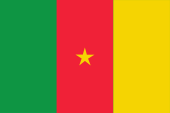 |
Nationalflagge – national flag, Seitenverhältnis – ratio = 2:3, Quelle/Source: Corel Draw 4   |
historische Flaggen – historical Flags: |
|
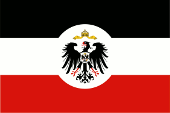 |
1893–1916, Dienstflagge Kolonialamt – official flag of colonial office, Seitenverhältnis – ratio = 2:3, Quelle/Source, nach/by: Wikipedia (DE)    |
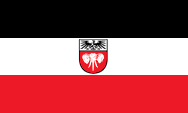 |
1914, |
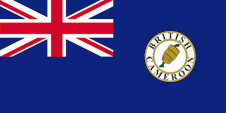 |
1919–1961, |
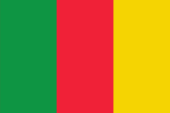 |
1957–1961, |
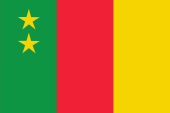 |
1961–1975, |
Bedeutung/Ursprung der Flagge – Meaning/Origin of the Flag: |
|
| Die heutige Flagge wurde am 20.05.1975 offiziell gehisst. Sie ist eine Änderung der bis dato gültigen Flagge und zeigt ebenfalls die nach dem Vorbild der französischen Trikolore angeordneten Farben Grün, Rot und Gelb. In der Mitte des roten Mittelstreifens befindet sich ein gelber fünfstrahliger Stern. In der Flagge Kameruns steht Grün für Waldreichtum und Hoffnung auf eine glückliche Zukunft, Gelb steht für die Savannen und Rot für Unabhängigkeit. Der Stern symbolisiert die nationale Einheit. | The
today's flag was officially hoisted on 20th of May in 1975. It is a
alteration of the hitherto valid flag and shows as well the by model of the
French tricolor arranged colours green, red and yellow. In the middle of the red middle stripe is situated a yellow five-pointed star. In the flag of Cameroon stands green for wood riches and the hope for a lucky future, yellow stands for the savannas and red for the independence. The star symbolizes the national unity. |
| Die
Farbkombination von Grün, Gelb und Rot sind die panafrikanischen Farben: Etwa 1900 setzte die Panafrika-Bewegung ein, die Gemeinsamkeiten aller Menschen mit schwarzer Hautfarbe hervorheben wollte. Für die politische Einheit Afrikas steht der Farbendreiklang Grün-Gelb-Rot, den viele afrikanische Staaten nach Erlangung ihrer Unabhängigkeit in ihre Flaggen übernahmen. Das erste Land war Ghana im Jahr 1957. Als Ursprung gelten die Landesfarben von Athiopien (Abessinien), dem ältesten unabhängigen Staat Afrikas. |
The
combination of the colours green, yellow and red are the pan-african
colours: Perhaps in 1900 was the beginning of the Panafrica-Movement, wich wants to emphasize the commons of all people with black skin. For the political unity of Africa stands the colour-triad green-yellow-red, wich used many african countries in their flags after the independence. The first country was Ghana in 1957. As the origin apply the colours of Ethiopia (Abessinia), the oldest independent state in Africa. |
| Der weit international verbreitete Farbendreiklang von Grün, Gelb und Rot scheint farblich nicht verbindlich festgelegt zu sein, auch nicht für Kamerun selbst. Folgende Farbwerte für den Farbendreiklang sind bekannt, sie sind beim Internationalen Olympischen Komitee (IOC) hinterlegt: Grün = Pantone 355, Rot = Pantone 032, Gelb = Pantone 109. |
The colour triad of
green, yellow and red, which is widely used internationally, does not seem
to be binding in terms of colour, not even for Cameroon itself. The following colour values for the colour triad are known, they are deposited with the International Olympic Committee (IOC): Green = Pantone 355, Red = Pantone 032, Yellow = Pantone 109. |
| Als deutsche Kolonie verwendete das Land keine besondere Nationalflagge. Es galten die Farben des Deutschen Reiches: Schwarz, Weiß und Rot. Behörden verwendeten die Flagge des Kolonialamtes sowie Abarten davon. Diese war zwar schwarz, weiß und rot waagerecht gestreift und zeigte in der Mitte eine weiße Scheibe mit dem Reichsadler. | As a German colony, the country did not use an own or special flag. There were used the colors of the German Empire: black, white and red. Authorities used the flag of the Colonial Office as well as varieties of it. That was black, white and red horizontally striped and showed in the middle of it a white disc with the imperial eagle. |
| Ab 1913 wurde überlegt, für die Kolonien eigene Hoheitszeichen zu schaffen. Erste Entwürfe lagen 1914 vor, jedoch wurde das Projekt wegen des Ausbruchs des Ersten Weltkriegs und wegen des Verlusts der Kolonien nicht mehr realisiert. |
From 1913 it was considered to create own emblems for the colonies. First drafts were made in 1914, but the project was not realized because of the outbreak of the First World War and because of the loss of the colonies. |
| Quelle/Source: Die Welt der Flaggen, Flaggen Wappen Hymnen, Wikipedia (DE), Flags of the World | |
Wappen – Coat of Arms: |
|
 |
1914, geplantes Wappen von Deutsch-Kamerun – planned coat of arms of German Cameroon, Quelle/Source: Flags of the World, Flag Reconstruction following Mark Sensen (Feb 98) based on traditional interpretation from Afrika-Nachrichten article 1933 |
 |
1960–1961, Wappen von Kamerun – coat of arms of Cameroon, Quelle/Source, nach/by: Wikipedia (FR), basing on Corel Draw 4 |
 |
1961–1972, Wappen von Kamerun – coat of arms of Cameroon, Quelle/Source, nach/by: Wikipedia (FR), basing on Corel Draw 4 |
 |
1972–1984, Wappen von Kamerun – coat of arms of Cameroon, Quelle/Source, nach/by: Wikipedia (FR), basing on Corel Draw 4 |
 |
seit/since 1984, Wappen von Kamerun – coat of arms of Cameroon, Quelle/Source, nach/by: Wikipedia (FR), basing on Corel Draw 4 |
Bedeutung/Ursprung des Wappens – Meaning/Origin of the Coat of Arms: |
|
| Mit der Unabhängigkeit wurde ein Wappen angenommen, das einen durch eine rote Spitze gespalten Schild in Grün und Gold darstellte. Auf der roten Spitze die blaue Landkarte Kameruns, ein schwarzes Schwert und die Waagschalen der Gerechtigkeit. Im oberen Teil des grünen und goldenen Feldes befand sich je ein fünfzackiger blauer Stern. Hinter dem Schild waren zwei sich kreuzende goldene Liktorenbündel. Das Spruchband über dem Wappenschild zeigte den Landesnamen in französischer Sprache und das Datum der Unabhängigkeit, das Spruchband unter dem Wappenschild in französischer Sprache das Motto: "Paix, Travail, Patrie" → "Frieden, Arbeit, Vaterland". | On the
occasion of the independence was adoped a coat of arms which pictured a by a
red angle splited shield in green and gold. On the red angle the blue map of Cameroon, a black sword and the pans of justice. In the upper parts of the green and golden fields was one five-pointed blue star. On the reverse of the shield were two crossing golden Liktor's bundles. The motto ribbon above the blazon showed the name of the country in French language and the datum of the independence, the motto ribbon below the blazon in French language the motto: "Paix, Travail, Patrie" → "Peace, Work, Fatherland ". |
| Das heutige Wappen wurde mehrfach geändert. So wurde 1975 der blaue Stern vom grünen Feld entfernt. 1984 wurde auch der blaue Stern vom goldenen Feld entfernt, jedoch ein goldener Stern in das grüne Feld eingefügt. Außerdem wurde das Datum der Unabhängigkeit weggelassen. Das heutige Staatswappen Kameruns wurde im Jahr 1986 geschaffen. Es ist wieder eine Änderung des bisher gültigen Modells und zeigt nunmehr den goldenen Stern an der Spitze des roten Feldes. Das Spruchband unterhalb des Wappenschildes zeigt eine andere Form und den Landesnamen in französischer und jetzt auch in englischer Sprache. Das Motto des Landes ist ebenfalls zweisprachig in einem Halbkreis oberhalb des Wappenschildes angeordnet worden: "Paix, Travail, Patrie" bzw."Peace, Work, Fatherland" → "Frieden, Arbeit, Vaterland". | The
today's coat of arms was several times changed. In this way was in 1975
removed the blue star from the green field. In 1984 was even removed the
blue star from the golden field, but added a golden star into the green
field. Moreover was deleted the datum of independence. The today's coat of arms of Cameroon was created in 1986. It is again a change of the hitherto valid model and showes now the golden star on the top of the red field. The motto ribbon below the blazon shows an other style and the name of the country in French and now even in English language. The motto of the country is likewise bilingual grouped in a semicircle above the blazon: "Paix, Travail, Patrie" → "Peace, Work, Fatherland". |
| Das Land war einst eine deutsche Kolonie. Die deutschen Kolonien unterstanden – Kiautschou ausgenommen – dem Reichskolonialamt. Entsprechend verwendeten Behörden dessen Siegel, Flaggen und das Reichswappen. | The country was once a German colony. The German colonies – except Kiaochow – had been subordinated under the Imperial Colonial Office. Accordingly, public authorities used its seals, flags, and the Imperial coat of arms. |
| Ab 1913 wurde überlegt, für die Kolonien eigene Hoheitszeichen zu schaffen. Erste Entwürfe lagen 1914 vor, jedoch wurde das Projekt wegen des Ausbruchs des Ersten Weltkriegs und wegen des Verlusts der Kolonien nicht mehr realisiert. |
From 1913 it was considered to create own emblems for the colonies. First drafts were made in 1914, but the project was not realized because of the outbreak of the First World War and because of the loss of the colonies. |
| Das gedachte Aussehen der Wappen und Flaggen konnte in den 20er und 30er Jahren des 20. Jahrhunderts anhand von Fragmenten lediglich rekonstruiert werden. Die meisten Rekonstruktionen beziehen sich auf einen Artikel der Zeitung "Afrika-Nachrichten" von 1933 und die daraus folgenden Rekonstruktionen des niederländischen Vexillologen Mark Sensen vom Februar 1998, die auch auf diesen Seiten berücksichtigt werden. |
The imaginary appearance of the coats of arms and flags could only be
reconstructed on the basis of fragments in the 20s and 30s of the 20th
century. Most of the reconstructions refer to an article in the newspaper "Afrika-Nachrichten" from 1933 and the subsequent reconstructions of the Dutch vexillologist Mark Sensen from February 1998, which are also taken into account on these pages. |
| Die Wappen selbst sollten oberhalb des Wappenschilds noch die Kaiserkrone tragen, jedoch nicht auf den Flaggen, wenn man der Rekonstruktion von Mark Sensen folgt. | The coats of arms themselves should additionally show the imperial crown above the escutcheon, but not on the flags, following the reconstruction of Mark Sensen. |
| Die Wappenschilde zeigten immer den gleichen Aufbau: Ein horizontal zweigeteiltes Schild, dessen Schildhaupt auf weiß den Reichsadler mit dem Brustschild des Hauses Hohenzollern zeigte. Im Hauptteil eine stilisierte Darstellung von Pflanzen, Tieren oder Landschaften, die je nach Land unterschiedlich gefärbt waren. | The escutcheons always showed the same structure: A horizontally twofold splited shield, the head of the shield showed the imperial eagle on white ground with the escutcheon of the House of Hohenzollern on the chest. In the main part appeared a stylized representation of plants, animals or landscapes, which were colored differently depending on the country. |
| Das geplante Wappen von Kamerun zeigte einen weißen Elefantenkopf auf rotem Grund. | The planned coat of arms of Cameroon showed a white elephant head on a red background. |
| Quelle/Source: Wikipedia (D), Die Welt der Flaggen, Flaggen und Wappen der Welt, Mark Sensen | |
Flugzeugkokarde – aircraft roundel: |
|
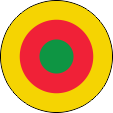 |
Flugzeugkokarde – aircraft roundel Quelle/Source: nach/by Wikipedia (EN) |
Landkarten – Maps: |
Lage – Position: |
Landkarte des Landes – Map of the Country: |
|
|
Kamerun 1884 bis heute – Cameroon from 1884 until today: |
|
|
|
Zahlen und Fakten – Numbers and Facts: |
|
|
|
|
|
|
|
|
|
|
|
|
|
|
|
|
|
|
|
Geschichte: |
| 1482 · der Portugiese Diego Cão entdeckt die Küste des heutigen Kamerun 15. Jhd. bis 1893 · der Norden des heutigen Kamerun gehört bis zum Ende des 19. Jhd. zum Staat Bornu 17. Jhd. · Kamerun erhält seinen Namen nach dem Krabbenfluss (Rio de Camarões) 1810 · in der Mitte des heutigen Kamerun entsteht das Emirat Adamaua 1868 · erste deutsche Faktorei in Kamerun 1884 · Gustav Nachtigal (1834–1885) annektiert die Küste Kameruns für das Deutsche Reich, Bildung der Kolonie Kamerun 1885 · Grenzverträge mit Großbritannien im Norden und Frankreich im Süden sowie militärische Aktionen erweitern das Gebiet der Kolonie 1894 · das Emirat Adamaua wird der Kolonie Kamerun angeliedert, Kamerun erreicht in etwa seine heutige Größe 1911 · das Deutsche Reich verzichtet im Norden auf das Bagirmi-Gebiet und erhält von Frankreich größere Gebiete im Osten und Süden 1914–1918 · Erster Weltkrieg 1916 · die deutschen Truppen (Schutztruppe) in Kamerun kapitulieren teilweise, das Land wird von Briten und Franzosen besetzt, ein kleiner Teil der Schutztruppe tritt auf neutrales spanisches Territorium in Spanisch-Guinea/Rio-Muni über, und lässt sich dort bis Kriegsende internieren 1920 · die Gebietsgewinne von 1911 werden von Frankreich eingezogen, das Versailler Diktat teilt das restliche Kamerun offiziell in ein französisches (Ostkamerun, 432.000 km²) und ein britisches Mandatsgebiet (Westkamerun 88.300 km²) des Völkerbundes, das britische Gebiet wird von Nigeria aus verwaltet 1947 · Gründung der UPC (Union des Populations de Cameroun), Forderung nach Wiedervereinigung und Unabhängigkeit 1955 · die UPC beginnt den bewaffneten Kampf, Guerillakrieg bis 1965 1958 · Frankreich gewährt Ostkamerun Autonomie im Rahmen der Französischen Gemeinschaft 01.01.1960 · Unabhängigkeit für Ostkamerun 01.10.1961 · der Süden von Britisch-Kamerun (Westkamerun) vereinigt sich nach einer Volksabstimmung mit Ostkamerun zur Bundesrepublik Kamerun, der Norden Westkameruns wird an das seit 01.10.1960 unabhängige Nigeria angeschlossen 1972 · neue Verfassung, das föderalistische System wird abgeschafft, Proklamation der Vereingten Republik Kamerun 1993 · Grenzstreitigkeiten mit Nigeria 1994 · ethnische Unruhen 1993 · erneute Grenzstreitigkeiten mit Nigeria 1999 · Unruhen zwischen der englischsprachigen und der französischsprachigen Bevölkerung, Separatisten proklamieren die englischprachige Bundesrepublik Südkamerun (Ambazonia) 2000 · Wahl eines Präsidenten in Südkamerun (Ambazonia) |
History: |
| 1482 · the Portugese Diego Cão discovers the coast of the today's Cameroon 15. cent. to 1893 · the north of the today's Cameroon belongs until the end of the 19th cent. to the State of Bornu 17. cent. · Cameroon gets its name after the Crab River (Rio de Camarões) 1810 · in the middle of the today's Cameroon rises a Emirate of Adamaua 1868 · first German factory in Cameroon 1884 · Gustav Nachtigal (1834–1885) annexes the coast of Cameroon for the German Empire, establishment of the Colony of Cameroon 1885 · frontier treaties with United Kingdom in the north and France in the south as well as military campaigns extend the area of the colony 1894 · the Emirate of Adamaua is annexed by the Colony of Cameroon, Cameroon achieves approximately its today's dimension 1911 · the German Empire waives the Bagirmi Region in the north and receives from France important areas in the east and south 1914–1918 · First World War 1916 · the German troops (Schutztruppe) in Cameroon surrender partly, the country is occupied by the British and French, a small part of the Schutztruppe crosses the border to neutral Spanish territory in Spanish Guinea/Rio Muni, and is interned there until the end of the war 1920 · the territorial gains from 1911 are conscripted by France, the Versailles Dictate splits the residual Cameroon officially into a French (Eastern Cameroon, 166.795 sq.mi.) and a British mandate (Western Cameroon 34.093 sq.mi.) of the League of Nations, the British zone is administered from Nigeria 1947 · foundation of the UPC (Union des Populations de Cameroun), claim for reunification and independence 1955 · the UPC starts the armed struggle, guerilla war until 1965 1958 · France grants Eastern Cameroon autonomy in the framework of the French Community 1st of January 1960 · independence for Eastern Cameroon 1st of October 1961 · the south of British Cameroon (Western Cameroon) unites after a plebiscite with Eastern Cameroon to the Federal Republic of Cameroon, the north of Western Cameroon gets annexed to the since 1st of October 1960 independent Nigeria 1972 · new constitution, the federalistic system gets abolished, proclamation of the United Republic of Cameroon 1993 · frontier quarrels with Nigeria 1994 · ethnic riotings 1993 · once more frontier quarrels with Nigeria 1999 · riotings between the English speaking and the French speaking population, separatists proclaim the English speaking Federal Republic of South Cameroon (Ambazonia) 2000 · election of a president in South Cameroon (Ambazonia) |
| Quelle/Source: Atlas zur Geschichte, Wikipedia (D) |
Ursprung des Landesnamens – Origin of the Country's Name: |
|
| Der Name des Landes geht auf die Portugiesen zurück, als sie die Zuflüsse der Wouri-Mündung befuhren und die viele Krabben (Camarões) vorfanden, nannten sie den ganzen Fluss "Krabbenfluss" (Rio de Camarões). Dieser Name übertrug sich im 16. Jahrhundert auf das gesamte Gebiet im Hinterland der Mündungsbucht. | The name of the country goes back to the Portuguese, when they came with their ships into the inlets of the Wouri Estuary and they found many crabs (Camarões). So they called the whole river "crab river " (Rio de Camarões). This name was transferred to the entire area in the hinterland of the estuary bay in the 16th century. |
| Quelle/Source: Handbuch der geographischen Namen | |
Südkamerun – Southern Cameroons – Ambazonia: |
|
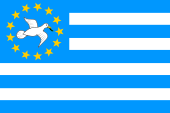 |
seit/since 2001, |
|
|
|
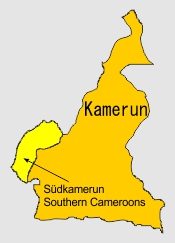 |
|